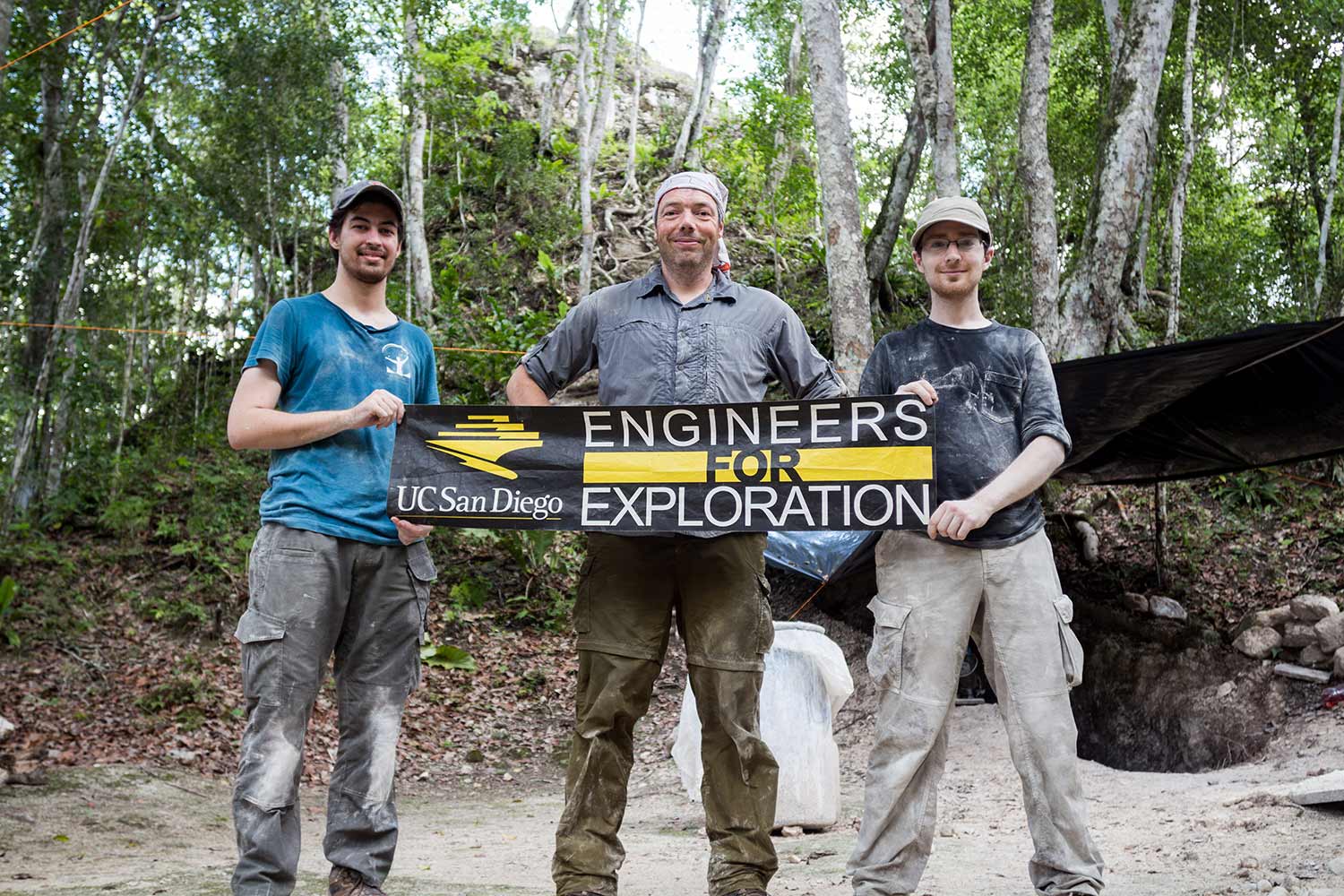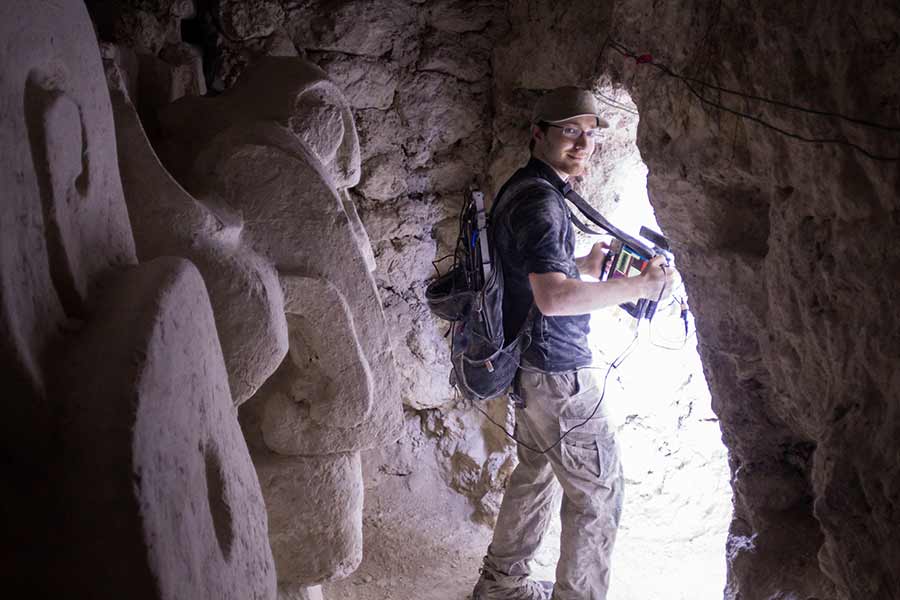
By:
- Becky Ham
- Katie E. Ismael
Published Date
By:
- Becky Ham
- Katie E. Ismael
Share This:

(l-r) Ph.D. student Peter Tueller, Professor Curt Schurgers and Ph.D. student Quentin Gautier at the E4E Guatemala field site. (Photo courtesy of Quentin Gautier)
Unearthing Mysteries of the Maya
UC San Diego Student Explorers Help Uncover Ancient Maya Tunnels
UC San Diego computer science students are venturing into Maya tunnels in Guatemala, and at home in San Diego, to bring these ancient buried sites to virtual life.
Using backpacks full of custom hardware in the field and cutting-edge virtual reality (VR) technology back on campus, these student adventurers are helping archaeologists visualize and preserve their complex excavations.
Part of the Engineers for Exploration (E4E) group, the students are guided by Computer Science and Engineering Professor Ryan Kastner and Electrical and Computer Engineering Professor Curt Schurgers.
Quentin Gautier, a computer science doctoral student, is among the team that is building a VR simulation of the archaeological tunnels excavated at El Zotz, a temple site near the ancient Maya center of Tikal. The simulation will soon provide researchers and the public a narrated 3D walkthrough of the tunnels and artifacts uncovered at the site, including elaborate masks and carvings that lined the tunnel walls.
No tunnel vision here
To bring this world above ground, the team is finding ways to maneuver around the physical and technical obstacles they have encountered.
“These tunnels that the archaeologists dug are very narrow—just enough to let a human pass by. We have to be careful moving around the ancient artifacts in there because the structure of our backpack is metal and sharp and the masks [on the walls] are fragile,” Gautier said.
He added: “The heat and humidity of the site are very different from the comfort of the lab, and the heat is so much that our instruments tend to fail toward the end of the season. We have to get very good at fixing things on the fly.”

Quentin Gautier tests the custom 3D scanning system at the M7-1 temple excavation at the El Zotz archaeological site. (Photo by Curt Schurgers)
Gautier and his colleagues had to engineer a method to collect billions of data points while dealing with those constraints. They developed a backpack with a built-in power source and 3D scanning and mapping hardware that is small enough to wear in the tunnels without damaging irreplaceable artifacts, and tough enough to withstand the heat and humidity of the Guatemalan forest. The team connected the 3D scanning software with a motion-detecting tablet that could serve as a wearable scanning rig in the tunnels.
“Virtual reality is a very good medium to really feel what it’s like to be an archaeologist working in the narrow, dusty, humid tunnels,” said Gautier. “VR can give us the real scale of the environment.”
The VR simulation will be built from billions of data points collected over the past five years of the Maya mapping project. It’s a challenging task, Gautier said, in part because not many researchers have experience with the technology. Members of the Triton XR club, a UC San Diego student group dedicated to exploring and creating virtual, augmented and mixed reality experiences, are helping Gautier develop the simulation.
The team will face additional technical challenges associated with converting the tunnel data into a more video game-like simulation. “The tunnel data are represented as a point cloud – a set of data points in space that is typically used in scientific visualization, whereas VR often uses data in a 3D mesh – a polygon-based structural representation,” Gautier explained.
Gautier and others have built a stripped-down VR simulation of one of the El Zotz tunnels, and hope to have a more detailed, narrative version of the simulation completed later in 2019.
The next frontier?
As Gautier moves on to helm the VR part of the project, Ferrill Rushton, an electrical engineering senior, has taken the lead on collecting the data from the tunnel scanning. Although he hasn’t made it out to Guatemala yet, Rushton has worked though hardware and software challenges as the team tests the scanning rig in the mud caverns of Anza-Borrego Desert State Park in eastern San Diego County.
Rushton says the project has helped him develop leadership and organization skills as well, especially useful as he brings new members up to speed.
“I think it shows my motivation and ability to learn new tools that I may need to tackle a project,” he said. “After all, in industry you almost never stick with one thing. Every project may require new knowledge, and being able to acquire that knowledge and quickly apply it is a skill in itself.”
Professor Kastner agrees. “Engineers for Exploration allows students to translate the skills that they learn in the classroom into technologies that are directly applicable to our scientific collaborators. The students gain valuable system building expertise, develop a strong foundation for interdisciplinary research and get to travel around the world to deploy their technologies,” he said.
CSE students recently presented an update on the Maya mapping project at the inaugural CSE Research Open House in January 2019. E4E students are also working on mapping coral reefs in 3D, monitoring mangroves, and tracking tigers and elephants at the San Diego Zoo, among other projects.
E4E is now seeking students with an interest in computer vision and analytics to join its Tunnel Mapping and Baboons on the Move projects. To learn more about these and other projects, visit the Engineers for Exploration website.
Share This:
You May Also Like
Stay in the Know
Keep up with all the latest from UC San Diego. Subscribe to the newsletter today.


